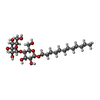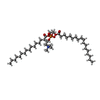[English] 日本語
 Yorodumi
Yorodumi- PDB-6cnn: Cryo-EM structure of the human SK4/calmodulin channel complex in ... -
+ Open data
Open data
- Basic information
Basic information
| Entry | Database: PDB / ID: 6cnn | |||||||||||||||||||||||||||||||||||||||||||||
|---|---|---|---|---|---|---|---|---|---|---|---|---|---|---|---|---|---|---|---|---|---|---|---|---|---|---|---|---|---|---|---|---|---|---|---|---|---|---|---|---|---|---|---|---|---|---|
| Title | Cryo-EM structure of the human SK4/calmodulin channel complex in the Ca2+ bound state I | |||||||||||||||||||||||||||||||||||||||||||||
 Components Components |
| |||||||||||||||||||||||||||||||||||||||||||||
 Keywords Keywords | MEMBRANE PROTEIN / ion channel / neuroscience / calmodulin | |||||||||||||||||||||||||||||||||||||||||||||
| Function / homology |  Function and homology information Function and homology informationintermediate conductance calcium-activated potassium channel activity / saliva secretion / small conductance calcium-activated potassium channel activity / stabilization of membrane potential / Ca2+ activated K+ channels / macropinocytosis / calcium-activated potassium channel activity / regulation of calcium ion import across plasma membrane / positive regulation of potassium ion transmembrane transport / cell volume homeostasis ...intermediate conductance calcium-activated potassium channel activity / saliva secretion / small conductance calcium-activated potassium channel activity / stabilization of membrane potential / Ca2+ activated K+ channels / macropinocytosis / calcium-activated potassium channel activity / regulation of calcium ion import across plasma membrane / positive regulation of potassium ion transmembrane transport / cell volume homeostasis / CaM pathway / Cam-PDE 1 activation / Sodium/Calcium exchangers / Calmodulin induced events / Reduction of cytosolic Ca++ levels / Activation of Ca-permeable Kainate Receptor / CREB1 phosphorylation through the activation of CaMKII/CaMKK/CaMKIV cascasde / Loss of phosphorylation of MECP2 at T308 / phospholipid translocation / CREB1 phosphorylation through the activation of Adenylate Cyclase / CaMK IV-mediated phosphorylation of CREB / PKA activation / negative regulation of high voltage-gated calcium channel activity / Glycogen breakdown (glycogenolysis) / positive regulation of ryanodine-sensitive calcium-release channel activity / CLEC7A (Dectin-1) induces NFAT activation / Activation of RAC1 downstream of NMDARs / negative regulation of calcium ion export across plasma membrane / organelle localization by membrane tethering / mitochondrion-endoplasmic reticulum membrane tethering / autophagosome membrane docking / presynaptic endocytosis / regulation of cardiac muscle cell action potential / negative regulation of ryanodine-sensitive calcium-release channel activity / Synthesis of IP3 and IP4 in the cytosol / regulation of cell communication by electrical coupling involved in cardiac conduction / positive regulation of T cell receptor signaling pathway / Phase 0 - rapid depolarisation / Negative regulation of NMDA receptor-mediated neuronal transmission / Unblocking of NMDA receptors, glutamate binding and activation / RHO GTPases activate PAKs / calcineurin-mediated signaling / Ion transport by P-type ATPases / Uptake and function of anthrax toxins / regulation of ryanodine-sensitive calcium-release channel activity / Long-term potentiation / Calcineurin activates NFAT / Regulation of MECP2 expression and activity / protein phosphatase activator activity / DARPP-32 events / Smooth Muscle Contraction / immune system process / catalytic complex / potassium channel activity / detection of calcium ion / regulation of cardiac muscle contraction / RHO GTPases activate IQGAPs / regulation of cardiac muscle contraction by regulation of the release of sequestered calcium ion / presynaptic cytosol / calcium channel inhibitor activity / cellular response to interferon-beta / Protein methylation / Activation of AMPK downstream of NMDARs / Ion homeostasis / regulation of release of sequestered calcium ion into cytosol by sarcoplasmic reticulum / eNOS activation / regulation of calcium-mediated signaling / Tetrahydrobiopterin (BH4) synthesis, recycling, salvage and regulation / titin binding / voltage-gated potassium channel complex / potassium ion transmembrane transport / sperm midpiece / substantia nigra development / calcium channel complex / calyx of Held / FCERI mediated Ca+2 mobilization / Ras activation upon Ca2+ influx through NMDA receptor / FCGR3A-mediated IL10 synthesis / adenylate cyclase activator activity / regulation of heart rate / Antigen activates B Cell Receptor (BCR) leading to generation of second messengers / protein serine/threonine kinase activator activity / VEGFR2 mediated cell proliferation / sarcomere / regulation of cytokinesis / VEGFR2 mediated vascular permeability / positive regulation of protein secretion / Translocation of SLC2A4 (GLUT4) to the plasma membrane / positive regulation of receptor signaling pathway via JAK-STAT / spindle microtubule / establishment of localization in cell / RAF activation / Transcriptional activation of mitochondrial biogenesis / defense response / potassium ion transport / Stimuli-sensing channels / cellular response to type II interferon / long-term synaptic potentiation / ruffle membrane / response to calcium ion Similarity search - Function | |||||||||||||||||||||||||||||||||||||||||||||
| Biological species |  Homo sapiens (human) Homo sapiens (human) | |||||||||||||||||||||||||||||||||||||||||||||
| Method | ELECTRON MICROSCOPY / single particle reconstruction / cryo EM / Resolution: 3.5 Å | |||||||||||||||||||||||||||||||||||||||||||||
 Authors Authors | Lee, C.H. / MacKinnon, R. | |||||||||||||||||||||||||||||||||||||||||||||
| Funding support |  United States, 2items United States, 2items
| |||||||||||||||||||||||||||||||||||||||||||||
 Citation Citation |  Journal: Science / Year: 2018 Journal: Science / Year: 2018Title: Activation mechanism of a human SK-calmodulin channel complex elucidated by cryo-EM structures. Authors: Chia-Hsueh Lee / Roderick MacKinnon /  Abstract: Small-conductance Ca-activated K (SK) channels mediate neuron excitability and are associated with synaptic transmission and plasticity. They also regulate immune responses and the size of blood ...Small-conductance Ca-activated K (SK) channels mediate neuron excitability and are associated with synaptic transmission and plasticity. They also regulate immune responses and the size of blood cells. Activation of SK channels requires calmodulin (CaM), but how CaM binds and opens SK channels has been unclear. Here we report cryo-electron microscopy (cryo-EM) structures of a human SK4-CaM channel complex in closed and activated states at 3.4- and 3.5-angstrom resolution, respectively. Four CaM molecules bind to one channel tetramer. Each lobe of CaM serves a distinct function: The C-lobe binds to the channel constitutively, whereas the N-lobe interacts with the S4-S5 linker in a Ca-dependent manner. The S4-S5 linker, which contains two distinct helices, undergoes conformational changes upon CaM binding to open the channel pore. These structures reveal the gating mechanism of SK channels and provide a basis for understanding SK channel pharmacology. | |||||||||||||||||||||||||||||||||||||||||||||
| History |
|
- Structure visualization
Structure visualization
| Movie |
 Movie viewer Movie viewer |
|---|---|
| Structure viewer | Molecule:  Molmil Molmil Jmol/JSmol Jmol/JSmol |
- Downloads & links
Downloads & links
- Download
Download
| PDBx/mmCIF format |  6cnn.cif.gz 6cnn.cif.gz | 363 KB | Display |  PDBx/mmCIF format PDBx/mmCIF format |
|---|---|---|---|---|
| PDB format |  pdb6cnn.ent.gz pdb6cnn.ent.gz | 290.2 KB | Display |  PDB format PDB format |
| PDBx/mmJSON format |  6cnn.json.gz 6cnn.json.gz | Tree view |  PDBx/mmJSON format PDBx/mmJSON format | |
| Others |  Other downloads Other downloads |
-Validation report
| Summary document |  6cnn_validation.pdf.gz 6cnn_validation.pdf.gz | 1.4 MB | Display |  wwPDB validaton report wwPDB validaton report |
|---|---|---|---|---|
| Full document |  6cnn_full_validation.pdf.gz 6cnn_full_validation.pdf.gz | 1.4 MB | Display | |
| Data in XML |  6cnn_validation.xml.gz 6cnn_validation.xml.gz | 56.3 KB | Display | |
| Data in CIF |  6cnn_validation.cif.gz 6cnn_validation.cif.gz | 77.4 KB | Display | |
| Arichive directory |  https://data.pdbj.org/pub/pdb/validation_reports/cn/6cnn https://data.pdbj.org/pub/pdb/validation_reports/cn/6cnn ftp://data.pdbj.org/pub/pdb/validation_reports/cn/6cnn ftp://data.pdbj.org/pub/pdb/validation_reports/cn/6cnn | HTTPS FTP |
-Related structure data
| Related structure data |  7538MC  7537C  7539C  6cnmC  6cnoC M: map data used to model this data C: citing same article ( |
|---|---|
| Similar structure data |
- Links
Links
- Assembly
Assembly
| Deposited unit | 
|
|---|---|
| 1 |
|
- Components
Components
-Protein , 2 types, 8 molecules ABCDEFGH
| #1: Protein | Mass: 47758.496 Da / Num. of mol.: 4 Source method: isolated from a genetically manipulated source Source: (gene. exp.)  Homo sapiens (human) / Gene: KCNN4, IK1, IKCA1, KCA4, SK4 / Production host: Homo sapiens (human) / Gene: KCNN4, IK1, IKCA1, KCA4, SK4 / Production host:  Homo sapiens (human) / References: UniProt: O15554 Homo sapiens (human) / References: UniProt: O15554#2: Protein | Mass: 16852.545 Da / Num. of mol.: 4 Source method: isolated from a genetically manipulated source Source: (gene. exp.)  Homo sapiens (human) / Gene: CALM1, CALM, CAM, CAM1 / Production host: Homo sapiens (human) / Gene: CALM1, CALM, CAM, CAM1 / Production host:  Homo sapiens (human) / References: UniProt: P0DP23 Homo sapiens (human) / References: UniProt: P0DP23 |
|---|
-Sugars , 1 types, 8 molecules 
| #5: Sugar | ChemComp-LMT / |
|---|
-Non-polymers , 3 types, 20 molecules 




| #3: Chemical | ChemComp-K / #4: Chemical | ChemComp-POV / ( #6: Chemical | ChemComp-CA / |
|---|
-Details
| Has protein modification | N |
|---|
-Experimental details
-Experiment
| Experiment | Method: ELECTRON MICROSCOPY |
|---|---|
| EM experiment | Aggregation state: PARTICLE / 3D reconstruction method: single particle reconstruction |
- Sample preparation
Sample preparation
| Component | Name: human SK4/calmodulin channel complex / Type: COMPLEX / Entity ID: #1-#2 / Source: RECOMBINANT |
|---|---|
| Source (natural) | Organism:  Homo sapiens (human) Homo sapiens (human) |
| Source (recombinant) | Organism:  Homo sapiens (human) Homo sapiens (human) |
| Buffer solution | pH: 8 |
| Specimen | Embedding applied: NO / Shadowing applied: NO / Staining applied: NO / Vitrification applied: YES |
| Vitrification | Cryogen name: ETHANE |
- Electron microscopy imaging
Electron microscopy imaging
| Experimental equipment |  Model: Titan Krios / Image courtesy: FEI Company |
|---|---|
| Microscopy | Model: FEI TITAN KRIOS |
| Electron gun | Electron source:  FIELD EMISSION GUN / Accelerating voltage: 300 kV / Illumination mode: FLOOD BEAM FIELD EMISSION GUN / Accelerating voltage: 300 kV / Illumination mode: FLOOD BEAM |
| Electron lens | Mode: BRIGHT FIELD |
| Image recording | Electron dose: 75 e/Å2 / Film or detector model: GATAN K2 SUMMIT (4k x 4k) |
- Processing
Processing
| Software | Name: PHENIX / Version: 1.12_2829: / Classification: refinement | ||||||||||||||||||||||||
|---|---|---|---|---|---|---|---|---|---|---|---|---|---|---|---|---|---|---|---|---|---|---|---|---|---|
| EM software | Name: PHENIX / Category: model refinement | ||||||||||||||||||||||||
| CTF correction | Type: PHASE FLIPPING AND AMPLITUDE CORRECTION | ||||||||||||||||||||||||
| Symmetry | Point symmetry: C4 (4 fold cyclic) | ||||||||||||||||||||||||
| 3D reconstruction | Resolution: 3.5 Å / Resolution method: FSC 0.143 CUT-OFF / Num. of particles: 91511 / Symmetry type: POINT | ||||||||||||||||||||||||
| Refinement | Highest resolution: 3.5 Å | ||||||||||||||||||||||||
| Refine LS restraints |
|
 Movie
Movie Controller
Controller









 PDBj
PDBj


























